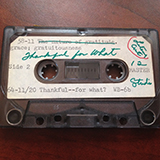Today Pitts Theology Library opened its first gallery exhibition in two years, “To Make the Voice Heard: Howard Thurman’s Prophetic Spirituality and Recordings During the Long Sixties.” The exhibition highlights audio selections from the library’s Howard Thurman Digital Archive along with items from the I.G. Bailey and Thurman Family Papers held by Emory’s Stuart A. Rose Manuscript, Archives, and Rare Book Library, offering a visual and auditory experience. The exhibition was curated by Timothy M. Rainey II, with support from Spencer Roberts, head of digital initiatives and technology at Pitts.

One of 763 audio cassette tapes in the Howard Thurman Digital Archive at Pitts.
The Howard Thurman Digital Archive is a collection of audio and film recordings of sermons, lectures, interviews, and readings by Thurman, who was among the most influential pastors, theologians, and proponents of nonviolence in the 20th century. Pitts is working to digitize the contents, which include 763 audio cassettes, 57 reel-to-reel audio tapes, and 14 reels of 16mm film, to make them accessible to a wider audience.
Curator Rainey first encountered the Howard Thurman Digital Archive in 2019 when he was a PhD student in the Laney Graduate School. He had what he calls an “incredible opportunity” to author the first round of metadata that would accompany the archive’s recordings. Now an assistant professor of religion at St. Olaf College, Rainey remembers that taking breaks from writing his dissertation to work on the digital archive did not feel like work. “Each assignment offered a reflective interruption amid the rapid pace of daily life.”
Given that experience, Rainey enthusiastically accepted the offer to curate this exhibition and wanted it to preserve that quality of introducing a reflective break to a visitor’s day.
“’To Make the Voice Heard’ invites audiences to pause, observe, and attempt a meditative encounter with the figure’s sonorous speech. Through recordings, photographs, and artifacts highlighting years of global ministry shared with his partner, Sue Bailey Thurman, visitors will find a Howard Thurman profoundly impacted by injustices in the world and committed to thinking broadly about the work of love and democratic hope,” he explains.
Howard and Sue Bailey Thurman spent nearly fifty years traveling the world, building interfaith networks and expanding how scholars and activists imagined the democratic community. A prolific writer and speaker, Thurman’s influence extended beyond the audiences he captivated in person and included the millions who would enter the room by way of his recordings.
“To Make the Voice Heard” illuminates how Thurman’s voice cultivated meditative encounters among audiences within whom he aspired to awaken a pursuit for common ground during an era of profound social transformation.
Rainey notes that Thurman introduced Mahatma Gandhi’s philosophy of nonviolence to civil rights discourse in the United States and was a ready resource for prominent civil rights leaders, including Martin Luther King, Jr.
“He often encouraged activists to rest and achieve ‘healing detachment.’ We hope that all who attend the exhibition adopt this wisdom and find within the woven fragments of Thurman’s life inspiration to relate to the world in fresh and meaningful ways.”
“To Make the Voice Heard” is open April 7–July 31 during library hours to Emory students, faculty, and staff, and the general public. Admission is free. Emory cards are required for entry for faculty, staff, and students. Visitors can make a reservation to visit the gallery at pitts.emory.edu/reservations.
